Dogs That Defied the Laws of Science
OR “How I learned to stop worrying and love the dog”
by The Late Mitchell Warren
Sponsored by the book “Raining Cats & Dogs“, by Mitchell Warren
Dogs of science remains an uncomfortable subject today, given our new standards of elevating canines to the deserving status of human beings, all the while we disregard anything that doesn’t have a snout and floppy ears. It’s time we accept our shame and admit we as the human species haven’t always been kind to dogs, but that our experiments on them have been fascinating. Even more fascinating are the science that dogs give to us without explanation-anomalies of nature that defy our conventional wisdom of what dogs should be. In this list of 13 dogs – dogs of science, dogs of sci-fi, and dogs of horror – we seek to prove only one point: that Dogs are truly Science’s Best Friend too.
1. Xinxiang the Runaway Pig Dog
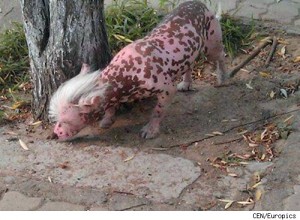
It takes a lot to make stoic China flinch these days, but Xinxiang, a pedigree breed Chinese hairless dog did just that, earning a reputation as a pig-dog mutant that must have surely escaped from a laboratory. Xinxiang is the only dog on our list credited to “natural dog science”. But China residents were spooked when this pink, hairless dog sporting a Mohawk and leopard-like spots showed up around Xinxiang City—and it just so happened there was a nearby scientific research center.
First gut reaction? Why of course, it’s an escaped genetic experiment gone horribly wrong, and the next step is surely a Chinese mutant pig-men military culminating in World War III. Actually, there are many “Xinxiangs” around the world, and they were originally bred to be a disabled person’s companion. Chinese Crested dogs are also not originally from China but believed to come from either Africa or Mexico; it was only when being taken to China that they were intentionally bred to be smaller in size.
Ironically, Xinxiang, the runaway Pig Dog, was an oddity. Most Chinese Crested dogs are introverted and are not known for gregarious behavior. And before you assume Xinxiang can travel across continents thus explaining her dozens of appearances worldwide, don’t be alarmed. Chinese Crested dogs pop up unexpectedly all over the place. One named Yoda won the 2011 World’s Ugliest Dog contest over at the Sonoma Marin Fair. Before Yoda’s rise to stardom, he lived on the street and was thought to be a giant rat.
2. Pavlov’s Drooling Dogs
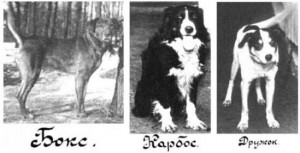
Russian physiologist Ivan Pavlov was certainly perplexed by his furry friends’ abilities, and this ultimately led him to work at the physiological department of the Veterinary Institute in St. Petersburg. While studying dog digestion, Pavlov became quite fascinated with doggy drool, which as we all know, they love to share with their human friends.
He noticed his subjects would start to salivate more whenever an assistant entered into the office. The team began measuring saliva production based on a number of foods and non-edible items. Saliva is a reflexive process, involuntary and a reaction to specific stimulus. Pavlov figured out that a dog’s drooling could result from the sight of the research assistants’ white lab coats, not merely hunger, since the dogs had learn to associate the sight with dinnertime. Salivating to the expectation of food was a breakthrough, because it led us to the theory of mental conditioning. Pavlov manipulated his dogs further by associating the sound of a metronome with feeding, and the results were the same: whenever the sound occurred, the dogs drooled in anticipation.
The case was a landmark achievement in the study of science and psychology, and actually challenged what we knew then about the power of the human and animal mind. The theory of conditioning remains important to today’s understanding of behavioral modification, mental health treatment, and manipulative boyfriends and girlfriends that always get what they want. In case you’re wondering about the names of the dogs who changed the laws of psychology, they’re all hard to pronounce and in Russian, having names like Krasavietz, Novichok and Zloday. No wonder only the name “Pavlov” stuck.
3. Laika the Space Dog
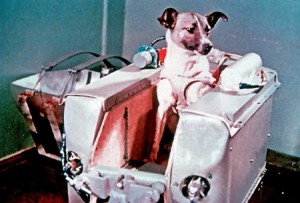
In America, you look down on your dog…in Soviet Russia, dog looks down on you! Literally, it seemed, as Laika was the first dog in space. Laika was once a female stray from Moscow, before being selected as the passenger of the Soviet spacecraft Sputnik 2, launched on November 3, 1957. Russian astronomers chose three-year old Laika because of her apparent ability to endure harsh conditions, including cold and starvation.
Laika’s breed was never confirmed, but she generally looked like a mix between a terrier, husky and possibly a Nordic breed. Her personality was said to be quiet and non-quarrelsome in comparison to other dogs. To prepare her for the ultimate dog science-defying leap around the world, she was housed in progressively smaller cages and then eventually released into orbit to serve as the first dog astronaut and a precursor to later human missions. While it would have been nice to report Laika landed safely and enjoyed a Buzz Aldrin-like legend, the truth is much more Old Yeller than Lassie.
It was long believed that she either died on day six from a lack of oxygen, or that she was euthanized via poison food capsule. She died from overheating, as details of her mission were released only as recently as 2002. Animal rights activists in 1957 expressed their outrage. National Canine Defence League of the U.K. called on all dog owners to observe a minute’s silence, and the Royal Society for the Prevention of Cruelty to Animals (RSPCA) received numerous protests.
Even one of the scientists responsible for sending Laika into dead space eventually recanted for the decision after the fall of the Soviet Union. And before you think a guy like Vladimir Putin to be cold and unsympathetic, know that in 2008 Russian officials erected a monument to Laika in Moscow, featuring a statute of a dog standing on top of a rocket. Neil Armstrong’s dog would have been proud.
4. Mira the World’s First Cloned Pet Dog

We are not just near the age of cloning but are in the age of cloning, and genetic clones are already walking among us. The world’s first “Frankenstein pet”, Mira, looks like any other dog; she’s part Husky, part Border Collie, and part Rottweiler. She’s also the good old age of seven and a living clone of a real dog. She cost a bark-worthy figure of £12 million pounds to make and was the vision of our planet’s very own Dr. Frankenstein, Lou Hawthorne.
Hawthorne worked in cloning for twenty years and gave life to 20 other genetically engineered dogs. However, just as Dr. Frankenstein met his own dark fate, so too did Hawthorne—although admittedly he was not choked to death by his creation. His own sense of guilt forced him out of the industry. For every one cloned pet, it is estimated that a high number of real dogs are put down. Up to 80 different dogs are required to create the genetic parts of one clone, a huge number of dog orders. These numbers could only be filled by big dog farms, and in Asia, dogs are used as meat or simply put down.
Hawthorne told the press, “A cloned dog contributes to the happiness of a family but I do not think it is possible to do it without a huge amount of suffering to hundreds of others.” There have been approximately 200 cloned dogs brought into existence through modern science thus far and they all seem to be living rich, full lives. Human cloning is not doing very well, however, as only Alec Baldwin seems to get steady work among his litter.
5. Naki’o The Bionic Dog
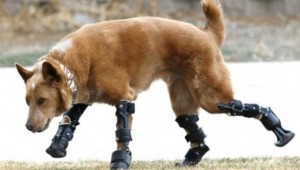
Whoever said cyborg beings had to be evil? Darth Vader and T-800 references notwithstanding, the first known bionic dog Naki’o, is surely not evil but definitely part machine. The mixed breed seemingly lost all hope, as he lost his paws because of frostbite. He was abandoned in a foreclosed Nebraska home and discovered alone in a puddle of icy water. Not only did he lose his four paws, but he also lost the tip of his tail, shortly before being rescued and taken to an animal rescue center.
Before the miracle of modern science, Naki’o was left with rounded stumps and couldn’t play well with other dogs, as it hurt to stand and he could only manage to crawl on his stomach. Luckily, this stray was adopted by veterinarian assistant Christie Pace of Colorado Springs, who came up with the idea of fitting him with four prosthetic limbs. They are not artificial stilts, but highly advanced prosthetics, created to mimic the muscle and bone of dog limbs, allowing the pup to do everything that comes natural.
Orthopets, the company that fitted Naki’o’s new paws, initially gave him two artificial back legs (made with mountain bike tire material), but was so impressed with Pace and Naki’o’s enthusiasm, they did his front legs too, and free of charge. Not quite RoboDog, but he is on record as being the first canine to be fitted with a full set of bionic paws. There is already talk of Naki’o being upgraded by a company called Omni Consumer Products (OCP) and turning Detroit into Delta City 2.0.
6. BigDog the Quadruped Robot

The nice thing about having a robot dog is having none of the mess to scoop up, although breeding is problematic and probably painful. BigDog is certainly not the world’s first robot dog—there were numerous primitive models here and there—but it is the world’s most amazing artificially created dog. The Defense Advanced Research Projects Agency (D.A.R.P.A., although it would have been funnier if they were called B.A.R.K.) funded the creation of BigDog, hoping it could be used as a robot pack mule to accompany soldiers into difficult terrain.
BigDog moves like a dog, using four legs, giving it an advantage over military vehicles. However, BigDog is far too expensive to merely scratch himself and bark at the moon. This critter has 50 sensors built into his body, as well as a stereo vision system and laser gyroscope. The computer-controlled dog-bot has helped to reduce the physical load soldiers have to carry. The project head, Dr. Martin Buehler, wasn’t content to retire early with just one robot dog. He has developed several four-legged walking and running robots. BigDog might well be the best, as he is capable of walking on ice and even capable of getting back up after a sidekick. Proof of BigDog’s brilliant technology is the fact that the Transformers “Ravage” cat-bot is scared to death of him.
7. The Montauk Monster
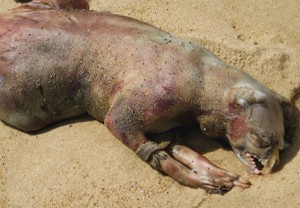
The Montauk Monster has been called everything from a raccoon, to a sea turtle, to a genetic lab experiment, to a special effect latex puppet. The Montauk Monster was first spotted in Montauk, New York as it washed ashore a beach in 2008 looking downright alien.
Pictures of the beast that circulated online offer no light as to what the creature is, since it appears to have a deformed face and indistinguishable feet. However, many experts are starting to accept that it is not a hoax and that it’s probably canine. According to an analysis of the creature, its legs are too long to be a raccoon, and it clearly does have fur, eliminating the possibilities of turtles, and sharp teeth, eliminating the suspect of sheep.
Regarding the possibility that the Monster is a giant rat (not any less creepy, guys!) is the fact that the beast does not have two large and curved incisor teeth in the front like rodents do. That leaves a dog as the most likely explanation, albeit a poor canine soul that decomposed in water for months or years on end. Disease may have also played a part in disfiguring the animal, as William Wise, director of Stony Brook University’s Living Marine Resources Institute, told the press. The legend of Montauk’s mutant dog will only grow as the carcass has been mysteriously misplaced and lost. But Giorgio A. Tsoukalos is fairly sure it’s aliens. (Dramatic Gesture)
8. Texas Blue Dogs
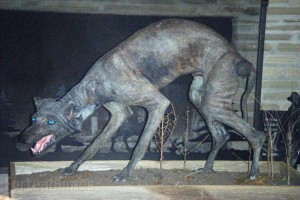
As if Texas didn’t have enough problem with Big Flying Birds and haunted hotels, there is also the legend of “Blue Dog”, which has merited comparisons to the mythical el chupacabra legend—a vampiric beast that feasts upon blood from livestock. The Blue Dog of Texas certainly did not look like a typical dog, given that it was hairless and had bluish skin. One eyewitness, Phylis Canion, claimed about the time she noticed the beast that some of her chickens were found dead and apparently drained of blood.
She did what any YouTube conscious citizen would have done next—make a video of the sight. On July 2007, another one was found and sure enough it looked bizarre. The dead animal’s body had unusually large ears, fanged teeth, and an almost elephant-like tint in the skin. Scientists heard of her story and decided to test the supposed chupacabra’s DNA but later found that it was not undead, and most certainly a member of Canidae. A coyote or Canis latrans, to be exact, a relative of the common dog.
It gets more peculiar, as a second DNA test revealed the Blue Dog resulted from a coyote mother getting kinky with a Mexican wolf father. Furthermore, the blue skin was most likely caused by a mite-related skin disease called sarcoptic mange. Nevertheless, Phylis Canion had the hybrid animal taxidermied and now proudly displays the closest thing we have ever found to resembling a chupacabra in her home. Of course, why you’d actually a want a vampire-esque beast inside your home scaring you every time you walk into the living room is anyone’s guess.
9. Dead Zone Dogs

If you’ve ever played video games like Fallout thenthe idea of radiation-affected mutant dogs might seem too silly an idea to be scary. However, there’s nothing fictional or funny about the reality of the Fukushima nuclear accident—and the dogs it has affected.
Scientists have speculated that the next generation of puppies living around the Fukushima Daiichi nuclear disaster zone are in living mutants dogs—and most likely vicious ones at that. Japanese officials are taking the threat seriously and are capturing hundreds of wild radiation-crazed dogs still living in the Fukushima no-entry zone, but are not succeeding in capturing the entire population. The dogs are reportedly becoming more antisocial and wild, as they do not interact with humans in the fallout zone. Furthermore, if the nuclear-affected dogs have their own puppies, they will be one more generation removed from civilized dogs—wild canines with no experience around people whatsoever.
The “dead zone dogs”, as they are nicknamed, are not responding to usual baited cage traps. Worse yet, as Kawasaki veterinarian Kunitoshi Baba states, “If infected dogs go outside the zone and attack people, disease could spread.” Photos of mutated animals from Fukushima have been spotted online, and one can only wonder and shudder at what a race of mutant dogs might look like in the real world. Probably not as horrific as this fellow.
10. Hitler’s Talking Dogs
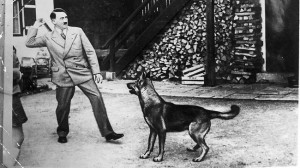
Say what you will about Hitler’s anti-social tendencies, the man clearly loved science…and dogs. Which brings us to the most bizarre case of misplaced animal love we’ve heard all day—talking dogs sponsored by the Nazis. Dr. Jan Bondeson of Cardiff University School of Medicine in Wales wrote a book on the Nazis’ ambitious dog experiment, and revealed that Hitler supported a German school that taught mastiff breeds to effectively talk to humans. According to reports, they did manage to train the dogs to learn a few words, mainly replying to questions like “Who is Adolf Hitler?” with “Mein Fuhrer!”
Speculation on why this was so important to Hitler revealed possible conspiracies to develop super-intelligent canine storm troopers, capable of communicating with soldiers. There was even talk of an “intellectual” Airedale terrier named Rolf who supposedly learned the alphabet, which he related with a series of paw-taps on a board, as well as other subjects. Beyond their plans for super intelligent evil dogs, the Nazis just happened to love dogs in general. Hitler himself owned two German shepherds (are you surprised?) named Bella and Blondi. Another rumor from The Guardian reported that the Nazis learned of a rebellious Finland dog owner who trained his dog to parody Hitler’s ultra-serious salute—which only incurred the wrath of the Third Reich, and provoked them into unsuccessfully hunting down the first ever canine comedian and his owner.
11. Phantom Black Dogs
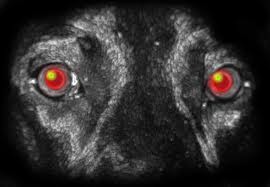
Phantom black dogs have been man’s best departed friend for hundreds of years, with sightings going back before the 1500s. The Black Shuck, as some accounts called it, was a dog with “fiery, saucer-shaped eyes” and one that appeared as an omen right before one’s own death. Multiple sightings are reported of phantom black dogs even now, as far as England, Scotland, Ireland, Mainland Europe and even into Latin America.
Viewers who see the dogs claim the creature is much larger than a normal dog, approximately the size of a cow by some accounts, and also has devilish or Hellhound-like glowing eyes. The most common areas where phantom dogs are reported include electrical storms, ancient sites, and the execution sites of prisoners. In books such as Explore Folklore, Explore Mythology, Explore Green Men, and Explore Shamanism, and Real Monsters, Gruesome Critters, and Beasts from the Darkside, eyewitness accounts are collected from the 1800s all the way to the present day, including small England villages like Ranton, Staffordshire, and the Cannock Chase forest in England, where sightings are still regularly reported.
Ironically, local urban myths of phantom cats are also coming out of Northern Ireland, Suffolk and London, which a skeptic will note, coincides with the “1976 Dangerous Wild Animals Act” in the U.K., which undoubtedly led to many pet owners releasing their exotic animal collection into the wild. One popular explanation of phantom dogs and cats is simply exotic breeds mating with domestic breeds, or long lost exotic and larger than average “pets” coming out of seclusion and roaming free. After all, everything looks bigger and creepier in the night. Interesting factoid: TV’s 1980s icon Foofur was based on artist renderings of phantom dogs. However, his eyes were black, not red, at least when he finally sobered up.

12. Demikhov’s Two-Headed Dog
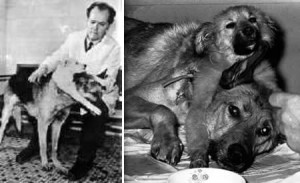
There is something unsettling about the idea or the visual of a two-headed dog, and that’s probably because of Cerberus, the Hellhound with three heads. Or maybe it’s because actually witnessing a living, breathing two-headed dog is a perversion of nature. Of course, that’s not nearly as disturbing as witnessing a perversion of science, like Soviet scientist Vladimir Demikhov’s two-headed dog.
Demikhov successfully grafted the head and forelegs of a smaller dog onto a larger dog. The smaller dog was named Shavka, and the larger dog Brodyaga. Both heads were responsive and moved independently of each other. The operation was a success for at least four days until the dogs died.
The experiment was repeated 24 times and photos were taken to prove its success. However, Demikhov did more than merely experiment. He also pioneered organ transplant theory, was also involved in lung and heart replacements in animals, and served as an army pathologist in World War II. Despite censure for unethical animal treatment in the 1950s, which resulted in a halt of all his experiments, he was later awarded an Order of Merit for the Fatherland prize and a USSR State Prize for his contributions to legitimate animal and surgical science. He also coined the phrase “two heads are better than one…” Well, not literally…but maybe he said something similar in Russian.
13. The Russian Zombie Dog
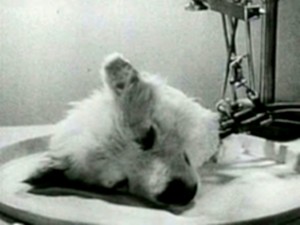
Perhaps the only kind thing you can say about the Nazis is that they really loved their dogs in comparison to the Soviet Union, who conducted all sorts of radical and cruel dog science experiments. The first zombie dog was created by Dr. Sergei Bryukhonenko, who successfully revived a dead dog, using a heart-lung machine called an autojector.
The scientist was able to pump the dog’s head back into operation, in essence returning it to life. To prove that the dog was actually aware of being alive, and not merely mechanically operating, the scientists provoked it into action and the dog head was shown—on video—licking a q-tip. A severed dog heart was also shown on video being kept alive through machinery. This happened prior to 1928 when video was officially released at the Third Congress of Physiologists of the USSR. It’s just a good thing they didn’t reanimate a Chihuahua, as once those little things get started they never shut up! We congratulate our brave Soviet dog subjects of year’s passed.
- http://dogtime.com/dog-breeds/chinese-crested#history
- http://psychology.about.com/od/classicalconditioning/a/pavlovs-dogs.htm
- http://en.wikipedia.org/wiki/Laika
- http://www.mirror.co.uk/news/world-news/cloned-dogs-scientist-lou-hawthorne-3402419
- http://www.dailymail.co.uk/news/article-2315616/The-bionic-dog-Mixed-breed-Nakio-lost-paws-frostbite-finally-walk-fitted-prosthetic-limbs.html
- http://en.wikipedia.org/wiki/BigDog
- http://web.archive.org/web/20080812043524/http://www.newsday.com/news/local/suffolk/ny-lijoye0731,0,7880502.column?page=2
- http://news.discovery.com/animals/mysterious-blue-dog-in-texas-claimed-to-be-chupacabra-130829.htm
- http://www.japantimes.co.jp/community/2013/12/30/issues/in-fukushima-abandoned-pets-are-multiplying/#.VA5r4KOunHY
- http://www.naturalnews.com/033644_Fukushima_mutants.html
- http://www.nytimes.com/2011/07/13/opinion/13dowd.html#h
- http://sf-fantasy.suvudu.com/2014/08/monster-dogs-of-myth-and-legend.html
- http://en.wikipedia.org/wiki/Black_dog_%28ghost%29
- http://mysteriousuniverse.org/2014/02/a-monster-that-endures/
- http://www.jfr.indiana.edu/review.php?id=257
- http://books.google.com/books?id=-nMYIB8JhxoC&pg=PA42&lpg=PA42&dq=phantom+black+dogs+accounts&source=bl&ots=&sig=RxtAefctdmxW3EGoXrCbduBqlW4&hl=en&sa=X&ei=dGgOVMDGPIbOggTIzoL4DA&ved=0CEYQ6AEwBTgK#v=onepage&q=phantom%20black%20dogs%20accounts&f=false
- http://www.urbanghostsmedia.com/2013/10/spectral-dogs-phantom-big-cats-uk-reality-myth/
- http://motherboard.vice.com/blog/soviet-scientists-made-this-two-headed-dog
- http://www.realclearscience.com/blog/2012/10/mad-scientists-of-the-modern-age-vladimir-demikhov.html
- http://www.theepochtimes.com/n3/501215-extremely-disturbing-soviet-zombie-experiments-reanimating-dead-animals/



Interesting write up and only somewhat racist against we canines, but I understand it’s in your limited human brains to do that. Here are my thoughts and refutations:
Xinxiang: Chinese hairless dogs really are freaks of nature. They’re the product of perverse breeding experiments, much worse than a lab.
Pavlov’s Dogs: Pavlov was evil. Why would you torment a dog like that? I can’t stand it when humans make me wait for feeding. Ask your starving African children how much they appreciate a metronome.
Laika: Laika’s death was yet another exploitation of man. However, I don’t think the idea of sending a dog into space is necessarily a bad one. I just think the Russians went about in a terrible way. I know of a relative of Laika’s family and they said, all heroism aside, she was a real bitch.
Mira: Mira is not a dog, not any of my species. She is pretty much like the BigDog robot. An abomination.
Naki’o: I personally would not have accepted man’s artificial limbs. I know some snake dogs and then get along just fine rolling on their bellies.
Montauk Monster: The Montauk Monster is not a dog. It is most likely extraterrestrial or perhaps a left over dinosaur. Dogs don’t look like that. That thing is scary!
Texas Blue Dogs: Blue Dogs have an attitude. They are addicted to blood. They are like your “stoners” to us dogs. All they want to do is eat blood and breed. I think they’re trashy myself.
Phantom Black Dogs: have known of some very large dogs, and to say they are the size of horses or cows would not be an impossibility. But just to warn you, posting pictures of Foofur is sort of like me posting pictures of a minstrel show. He is a stereotype and most of us don’t think he’s funny at all.
Demikhov and Bryukhonenko were savages! I would never subject a human, dog or even a cat to such ritualistic torture. I tell you, even those Samoyed Russian Sled dogs are some scary bitches. I wouldn’t want to be stuck in a kennel with those monsters.